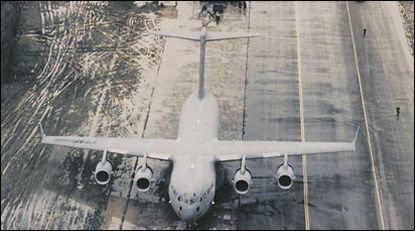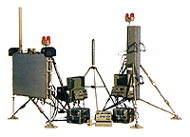|
Microwave
Landing System
The U.S. Air Force uses MMLS for rapid, round the
clock movement of cargo and troops, landing this C-17 aircraft in
Tirana, Albania.
Critical
to the Mission
MMLS meets the military's strict mobility, survivability and three-man
lift requirements and is capable of installation in less than two
hours. The system is also fully compliant with International Civil
Aviation Organization (ICAO) standards for Category I/II precision
approach guidance and landing. MMLS has been flight-certified by
the Federal Aviation Administration (FAA) at various locations worldwide.
MMLS has been installed at both domestic and international air force
bases around the globe for more than six years to support deployment
of ground forces, medical evacuations, humanitarian relief and pilot
training. The U.S. Air Force Mobility Command used MMLS to land
C-130 and C-17 aircraft in military resupply and humanitarian operations
recently performed in Bosnia, Kosovo, and Tirana (Albania). Additionally,
multiple MMLS systems were utilized to support missions in conflict
regions.
| The
World's Most Versatile Landing System
Textron Systems' MMLS is based on microwave technology, making
it less susceptible to the FM frequency and multi-path interference
inherent in conventional Instrument Landing Systems (ILS).
MMLS also provides wide guidance coverage and can accommodate
up to five times more aircraft than the less versatile ILS
systems. It outperforms ILS by minimizing |
 |
frequency modulation interference
and by allowing near-vertical recoveries in small or congested
landing areas.
Additionally, unlike traditional systems that support straight-in
approaches only, MMLS provides all-weather straight-line,
curved path and segmented approaches — even in topographically
challenging areas. |
Textron Systems' fielded MMLS employs azimuth and
elevation antennas* for center line and guide slope guidance; electronic
control units; precision DME for distance guidance; and field monitors
that continually verify the integrity of the MMLS signal. It accommodates
a variety of changing conditions at deployment sites, such as wind
and ground settling.
|

|

